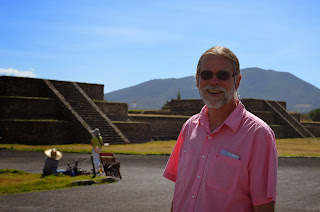November 5, 2014
Today was Teotihuacan, one of the most iconic tourist destinations
in Mexico. It’s about a 45 minute bus ride from one of the metro stops and
since it was Wednesday the crowds weren’t too bad. The place was amazing. A
ruin that was old before the Aztecs came there were, nonetheless, plenty of
vendors hawking Aztec chachkies. But even their presence couldn’t detract from
the sheer scope of the place. It’s huge in every way possible, size, vision,
age. We’ve seen some of the oldest construction built by Europeans in the
Americas. But this place leaves them all in the dust. The name Teotihucan means
“the place where the gods were created,” and you can believe it, looking at all
of the buildings, the very first planned metropolitan center in the Americas
and the 6th largest city in the world at its time, covering, at its
peak, over 30 square kilometers.
The place is packed with temples,
plazas, carved animals, and a
few lingering murals.
and a
few lingering murals. 
The buildings are strung out along a two mile avenue called the “Avenenue of the Dead,”
so named by the Aztecs, who seemed to be keen on death.
On one side of the Avenue of the Dead is the Pyramid of the Sun,
 the third largest pyramid in the world, and at the end the smaller, but
certainly no less impressive, Pyramid of the Moon.
the third largest pyramid in the world, and at the end the smaller, but
certainly no less impressive, Pyramid of the Moon.There’s some thought that the Pyramid of the Sun was actually a temple for the worship of the water god. But so much about the people who created this place is unknown, it’s hard not to refrain from sheer speculation.

Including a tomato plant, which seemed to be part of the excavation, doubtless more than a thousand years old.
After the decline of the original builders's culture new construction was added. In places you can see the one immediately over the other.
The stairways to the tops of the temples were steep.
Particularly those to the Pyramid of the
Moon.
Everywhere you could see a unique stone décor, using smaller stones set
between larger ones to create an iconic design.
Water drainage systems are still visible.

And there are stairways everywhere. In this high mountain air, climbing the steps is a workout. The sun is intense. The air is very dry. The vendors selling water and pop do the briskest business.
Crossing the Avenue of the Dead is a river that the
designers redirected from its banks to flow perpendicularly through the town.
But it is the Pyramid of the Sun and the Pyramid of the Moon
that draws the most visitors. Everyone wants to climb them. And it’s a good
workout. But well worth it. The view is spectacular.
And we took a look at a garden featuring some of the native plants to the area.
Then it was a bus ride and metro ride back after one of the most spectacular days of our visit.












































